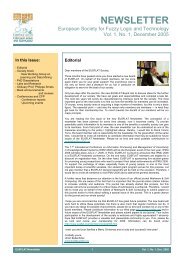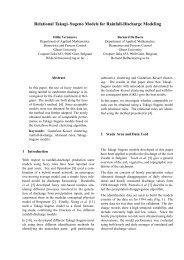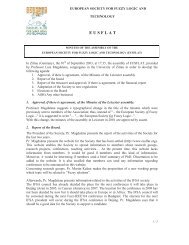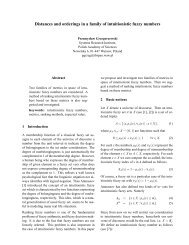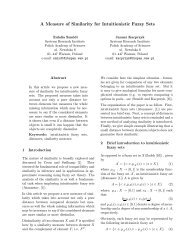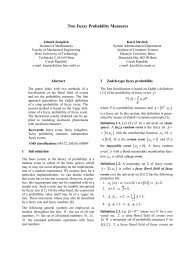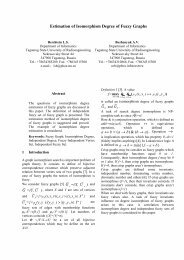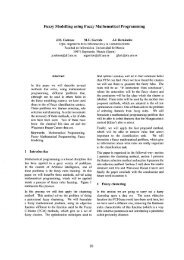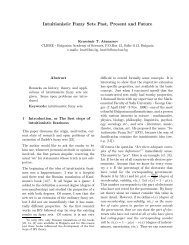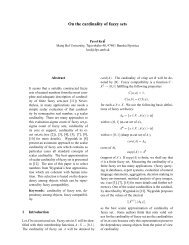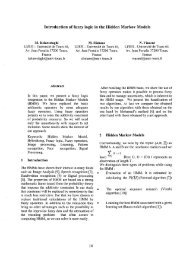Fuzzy Behavior Learning for Sony Legged Robots - EUSFLAT
Fuzzy Behavior Learning for Sony Legged Robots - EUSFLAT
Fuzzy Behavior Learning for Sony Legged Robots - EUSFLAT
Create successful ePaper yourself
Turn your PDF publications into a flip-book with our unique Google optimized e-Paper software.
<strong>Fuzzy</strong> <strong>Behavior</strong> <strong>Learning</strong> <strong>for</strong> <strong>Sony</strong> <strong>Legged</strong> <strong>Robots</strong><br />
Dongbing Gu and Huosheng Hu<br />
Department of Computer Science<br />
University of Essex, Wivenhoe Park, Colchester C04 3SQ, UK<br />
Email:dgu@essex.ac.uk, hhu@essex.ac.uk<br />
Abstract<br />
This paper presents a learning reac-<br />
tive control scheme <strong>for</strong> the <strong>Sony</strong> legged<br />
robots to play soccer. We built a<br />
behavior-based architecture that con-<br />
sists of a set of reactive behaviors and a<br />
deliberative reasoning component to se-<br />
lect or cc-ordinate the reactive behav-<br />
iors. The major reactive behavior is <strong>for</strong><br />
a <strong>Sony</strong> robot to move towards the ball,<br />
guided by on-board sensors. <strong>Fuzzy</strong> logic<br />
is used to encode the robot behavior.<br />
The learning of a FLC is conducted in<br />
two stages:learning parameters by GA<br />
and learnign its structure by Q-learning.<br />
Keywords: robot behavior, fuzzy logic<br />
controller, rein<strong>for</strong>cement learning, reac-<br />
tive control.<br />
1 Introduction<br />
<strong>Behavior</strong>-based robotic control is a strategy that<br />
decomposes complex robot tasks into a collection<br />
of behaviors. These behaviors tightly couple<br />
perception and motor responses and work in<br />
a co-ordinated manner to complete complex<br />
tasks. The behavior decomposition also leads to<br />
partitioning underlying physical space into a set<br />
of stable regions and decreasing in dimensions<br />
of input space <strong>for</strong> different behaviors. There is<br />
an increasing tendency to build up behaviors by<br />
using fuzzy logic controller (FLC) which makes<br />
robots be reactive and adaptive (11. In a FLC,<br />
uncertainty is represented by fuzzy sets and an<br />
action is generated co-operatively by several<br />
rules, each one triggering to some degree to<br />
produce smooth, reasonable and robust control<br />
effect.<br />
Problems in the design of a FLC are parameter<br />
setting of membership functions and composition<br />
of rules. They are classified into two catalogues:<br />
structure identification and parameter identi-<br />
fication [la]. The structure identification of a<br />
FLC includes the partition of its input space, the<br />
selection of antecedent and consequent variables,<br />
the determination of the number of IF-THEN<br />
rules, and the initial position of membership func-<br />
tions. In contrast, the parameter identification<br />
determines parameters of membership functions.<br />
Many learning approaches have been proposed<br />
to model a FLC, including neural network (NN)<br />
based, rein<strong>for</strong>cement learning (RL) based [l] [2]<br />
[3] [6] [7], and genetic algorithm (GA) based<br />
[4] [9] [14] [12] [15] [16] [17]. The NN-based<br />
FLC can automatically determine or modify .<br />
its structure and parameters by representing it<br />
in a connectionist way. The problem <strong>for</strong> the<br />
NN-based learning is that a large number of data '-.<br />
pairs have to be provided to train the neural<br />
networks. Both GA-based and &based learning<br />
are two equivalent learning schemes, wbich need<br />
a scalar response from real world by interacting<br />
with it to evaluate action per<strong>for</strong>mance [13] [19].<br />
Such a response can be a scalar value that is<br />
more easy to collect than the desired input and<br />
output data pairs in robot applications and can<br />
be any <strong>for</strong>ms without the differentiable limitation.<br />
Many GA-based learning schemes represent a<br />
FLC as an individual and the parameters of
membership function as its genes [9] [14]. In [4] Section 6 concludes the paper.<br />
and [12], authors had different evolution strategy<br />
where an individual represents a rule, not a FLC.<br />
Rules in one generation compete with each other<br />
in order to be selected. The credit to individuals<br />
was assigned according to their contribution and<br />
eligibility traces similar to temporal difference<br />
learning. In order to reduce the search space, the<br />
rules with same antecedents were grouped into a<br />
sub-population where the competence occurred<br />
[12]. The final FLC was constructed by selecting<br />
a rule from each sub-population.<br />
The RL-based learning includes two similar<br />
learning schemes: fuzzy Actor-Critic learning<br />
(FACL) and fuzzy Q-learning (FQL). FACL is<br />
used <strong>for</strong> parameter learning in [I.] [3] [I].] [16]<br />
and its difficulty is that it needs both an actor<br />
network and a critic network to converge. FQL<br />
is also viewed as a kind of Q-learning that uses<br />
fuzzy logic to generalize the mapping between Q<br />
values and sensory-action pairs. In [2] [6] [7], it<br />
was used to learn conclusion actions of a FLC.<br />
2 State space<br />
2.1 Sensors<br />
The main sensors embedded in each <strong>Sony</strong> legged<br />
robot include eighteen optical encoders <strong>for</strong><br />
motion control of eighteen motors, a color CCD<br />
camera, an infrared range sensor, and three gyros<br />
<strong>for</strong> posture measurement (roll, pitch, yaw) [5].<br />
The environment <strong>for</strong> <strong>Sony</strong> <strong>Legged</strong> Robot League<br />
in RoboCup is a playing field with the dimension<br />
of 3m in length and 2m in width. The goals<br />
are centered on both ends of the field, with a<br />
size of 60cm wide and 30cm high. Six unique<br />
colored landmarks are placed around edges of the<br />
field. The ball, walls, goals, landmarks and robot<br />
labels are painted with eight different colors<br />
distributed in the color space so that a robot can<br />
easily distinguish them. Object identification is<br />
a color-based processing that filters images based<br />
on a Color Detection Table(CDT) [lo].<br />
In this paper, we are investigating the problem<br />
of playing soccer by <strong>Sony</strong> legged robots in an 2.2 Spatial state representation<br />
environment where different objects can be recog-<br />
nized by different colors. The aim is to represent<br />
interactions between a robot and its environment<br />
as a set of local models by constraining specific<br />
behaviors to specific situations. There<strong>for</strong>e,<br />
dimensions of sensory input and action output<br />
are deduced and behavioral design can become<br />
relative easy. In each local model, individual<br />
behavior copes with local uncertainty appeared<br />
in the current sensory in<strong>for</strong>mation and provides<br />
real-time control response. In this way, behavior<br />
learning can also benefit from the reduced state<br />
space. We use FLC to encode the behaviors.<br />
The learning of a FLC will be conducted in two<br />
stages: learning parameters by GA and leaning<br />
structure by Q-leaning.<br />
The paper is organized as follows. Section 2 mod-<br />
els sensory in<strong>for</strong>mation. Section 3 presents a lay-<br />
ered representation of action space. The learning<br />
strategy is implemented in Section 4. The Ex-<br />
periment and simulation are given in Section 5.<br />
One way to gather spatial features from an dy-<br />
namic and uncertain environment to stimulate be-<br />
haviors is to continuously maintain a local map<br />
that includes relative position of objects in the<br />
view of robot on the playing field. The local in-<br />
<strong>for</strong>mation is also necessary to most of robot be-<br />
haviors, such as obstacle avoiding, wall following,<br />
goal achieving, docking, wandering, etc.<br />
The objects in a local map <strong>for</strong> soccer playing could<br />
be a ball, goals, beacons, ground, team-mates, o p<br />
ponents, and white edges depending on what the<br />
robot will see. Spatial state in<strong>for</strong>mation in a local<br />
map <strong>for</strong> each object B is defined as:<br />
B(Q, d, s, CV)<br />
8 is an angle reference to robot's orientation.<br />
It is calculated by pan angle p and tilt angle<br />
t reading from the head's encoders (see figure<br />
1).<br />
d is a distance between the robot and an ob-<br />
ject. It is read from infrared range sensor.
s is object's pixel size in the image. It is<br />
calculated by a morphology filter and the run<br />
length encoding (RLC) [8].<br />
CV is a certainty value. It acts as a memory<br />
<strong>for</strong> what is seen previously and will decay<br />
with time exponentially.<br />
3 Action space<br />
Figure 1: Spatial state space<br />
3.1 Primitive behaviors<br />
<strong>Sony</strong> legged robots are quadruped walking robots.<br />
Its neck and four legs have three degree of free-<br />
doms <strong>for</strong> looking and walking respectively. A set<br />
of primitive behaviors is build up as a basis <strong>for</strong> the<br />
legged robot movement. Figure 2 illustrates eight<br />
primitive behaviors. The reactive behaviors used<br />
to play soccer are based on this set of primitive<br />
behaviors and encoded by FLCs. On top of the<br />
action space, a temporal reasoning component is<br />
developed to select and co-ordinate the reactive<br />
behaviors to drive the robot to achieve the task.<br />
3.2 Reactive behaviors <strong>for</strong> an attacker<br />
To select and design robot behaviors depends<br />
upon robot's task and its environment. For a<br />
given environment like a paying field described<br />
previously, situated activity-based design is rea-<br />
sonable since robot's action can be predicated<br />
based on the situation where the robot finds it-<br />
self. For example, the robot needs to find the ball<br />
when the ball disappears from its view. If it finds<br />
the ball, the robot needs to approach the ball un-<br />
til it can manipulate the ball. This design method<br />
actually endows the behaviors with temporal and<br />
Figure 2: Action space<br />
spatial constrains. The spatial constrains can be<br />
represented in the local map on which the robot<br />
has to depends. The order <strong>for</strong> the robot's activi-<br />
ties <strong>for</strong>ms behavioral temporal constrains. For an<br />
attacker in our team, a set of behaviors is defined<br />
as follows:<br />
Standing up(SU): The robot should try to<br />
stand up from the beginning or when it falls<br />
down.<br />
Looking <strong>for</strong> ball(LB): This behavior will be<br />
triggered when the ball is lost from its view<br />
<strong>for</strong> long enough.<br />
Approaching ball(AB): The robot can move<br />
toward the ball when the ball is within its<br />
view.<br />
Looking <strong>for</strong> goal(LG): This behavior will end<br />
when the robot finds the goal or it knows the<br />
goal's location.<br />
Aligning with goal(AG): The robot tries to<br />
walk behind the ball in order to let the ball's<br />
position lie between the robot and the goal.<br />
Kicking ball(KB): The robot uses fast walk-<br />
ing command to move the ball into the goal.<br />
Backward looking(BL): This behavior just<br />
lets the robot move back <strong>for</strong> a few steps while
its head looks <strong>for</strong> the ball since the robot be-<br />
liefs the ball is in somewhere nearby when it<br />
just loses the ball.<br />
3.3 Temporal reasoning<br />
Each of the behaviors described above can be re-<br />
garded as a state in a time series process. The at-<br />
tacker's deliberative reasoning in temporal order<br />
<strong>for</strong> trying to get a score can be modelled as a dis-<br />
crete event system. A discrete event system can<br />
be represented by a hite state machine(FSM) by<br />
which implementation and verification of an ar-<br />
chitecture are easy to achieve. There are four el-<br />
ements in designing a FSM:<br />
Allowable states: There are seven states <strong>for</strong><br />
the attacker described above. They can be<br />
labelled as SU, LB, AB, LG, AG, KB, and<br />
BL respectively.<br />
State outputs: They indicate the correspond-<br />
ing behavioral execution.<br />
State inputs: They are predications based on<br />
the spatial in<strong>for</strong>mation and heuristic rules <strong>for</strong><br />
an attacker's role.<br />
State transition: It is expressed in figure 3<br />
where the circle represents the state, the arc<br />
with arrow represents transition direction,<br />
and the symbol near the arc represents state<br />
input.<br />
4 FLC <strong>Learning</strong> scheme<br />
4.1 <strong>Behavior</strong> fuzzy encoding<br />
A quadruple of (a, b, c, d) is used to represent the<br />
triangle or trapezoid membership function of a<br />
fuzzy set. The output action o is the primitive<br />
behavior that can be viewed as fuzzy singletons<br />
cm(m = 1, . . . , M) in a FLC. There are N rules <strong>for</strong><br />
each behavior. he membership degree of a fuzzy<br />
set FA of the nth input state variable s, in the<br />
ith rule is expressed as pFA(sn). The true value<br />
of the ith rule activated by an input state vec-<br />
tor S is calculated by Marndani's minimum fuzzy<br />
implication:<br />
/N0BAI.L;@3 FAR<br />
NEAR<br />
NO GOAL<br />
B?33<br />
f-01 :@\No<br />
NO BALL<br />
Figure 3: Finite state machine <strong>for</strong> the temporal<br />
reasoning<br />
The crisp output o stimulated by the input state<br />
S after the fuzzy reasoning is calculated by the<br />
center of area method (COA):<br />
4.2 <strong>Learning</strong> Reward<br />
The aim of the Approaching-ball behavior is to<br />
move towards the ball with an appropriate orien-<br />
tation to the goal. Reward should be designed to<br />
guide the evolution of the FLCs to achieve this<br />
purpose. The learning payoff is defined as:<br />
where wi (i = 1, ..., 5) is the weight, (8,s) are<br />
state variables, L is the number of the walking<br />
steps used in one trial. The first term in (3) in-<br />
dicates payoffs received during the whole move-<br />
ment. The second term rewards those FLCs that<br />
have fewer steps. The last three terms evaluate<br />
the final position of the robot.
4.3 Structure learning<br />
In the structure learning, the rule base of a FLC is<br />
learned by Q-learning using similar idea proposed<br />
in [6:1[8]. More specifically, the actions in conse-<br />
quences of a FLC are learned while the number<br />
of fuzzy rule is fixed. We divide sensory state<br />
space into different fuzzy sets and assign initial<br />
values <strong>for</strong> their membership parameters by rule<br />
of thumb. Then, the rule base is learned incre-<br />
mentally through backup updating with the ini-<br />
tial parameter values. There are several candi-<br />
dates <strong>for</strong> output action in a rule, each of which<br />
is assigned a Q-value that will be learned by Q-<br />
<strong>Learning</strong>. When the learning is finished, the ac-<br />
tion with the highest Q-value in a rule is selected<br />
as consequence <strong>for</strong> the rule.<br />
Since the sensory space is divided into grids ac-<br />
cording to the definition of input fuzzy sets, the<br />
rules that will be fired in a grid are <strong>for</strong>med as a<br />
local control model. The backup updating learn-<br />
ing starts from the grids near to the ball and will<br />
continue from them to those far from the ball. In<br />
this way, the search space is explored by backup<br />
updating instead of randomly exploration like GA<br />
learning since the size of grids is relative limited.<br />
The learned grids will be exploited, which make<br />
the learning works more effectively since the robot<br />
becomes increasingly aware of better control rules<br />
and capable of interact with its environment via<br />
these better control rules as learning progresses.<br />
4.4 Parameter learning<br />
In the parameter learning, further fine-tuning of<br />
the learned FLC will be carried out. For <strong>Sony</strong><br />
legged robots, output actions are discrete com-<br />
mands, each of which can make a robot move<br />
a single step in different directions. In this re-<br />
search, the parameter learning <strong>for</strong> input mem-<br />
bership functions is investigated by GA learning.<br />
A real value GA learning is adopted to optimize<br />
membership parameters.<br />
A FLC is encoded as one individual. In each gen-<br />
eration, a collection of individuals is maintained<br />
to compete with each other <strong>for</strong> survival. By evolv-<br />
ing through genetic operators, the best one will be<br />
selected as the optimal FLC <strong>for</strong> the behavior con-<br />
trol. There are three genetic operators employed<br />
in this process, namely reproduction, crossover,<br />
and mutation. The parameter learning procedure<br />
starts from random <strong>for</strong>mation of initial generation<br />
of a structured FLC. After completing the trial of<br />
one generation, GA evolves into a new generation<br />
and the learning repeats again until GA terminal<br />
condition is met.<br />
5 Experiment results<br />
Experiments <strong>for</strong> the real robot consists of the<br />
primitive behaviors, handcrafted reactive behav-<br />
iors and temporal reasoning. Figure 4(a) shows<br />
the results where an attacker is positioned near<br />
the goal initially and the ball is placed at the other<br />
side of the field. The robot first goes into the LB<br />
state where Looking- <strong>for</strong>-ball behavior is executed.<br />
Upon finding the ball, the robot transits into the<br />
AB state from the LB state 4(b). Figure 4(c)<br />
show how the robot tries to approach the ball in<br />
the AB state. Then, the robot starts to look <strong>for</strong><br />
the goal 4(d) and align itself with the goal until<br />
the directions of the ball and the goal fall in the<br />
given range 4(e). Finally, the robot kicks the ball<br />
into the goal by a fast-walking command 4(f).<br />
Figure 4: real robot experiment<br />
<strong>Fuzzy</strong> learning experiments are tested in a<br />
simulation environment where the exact size of<br />
the fled and the ball is built up. The dynamics<br />
of <strong>Sony</strong> legged robots is identified by measuring
the consequences of actual execution of each<br />
walking commands. In order to reflect real-world<br />
uncertainty, Gaussian noise is added in both<br />
motion dynamics and state variables during<br />
the simulation. One step delay is used in the<br />
command execution.<br />
The rule base is incrementally build up by the<br />
backup updating approach. Figure 5 shows<br />
the results <strong>for</strong> the Approaching-ball behaviour<br />
controlled by the FLC with the learned rule base.<br />
It can be seen that the robot can move to the<br />
ball although the robot do not exactly face the<br />
goal at final positions.<br />
Figure 5: The behavior after structure learning<br />
In parameter learning, the probability of<br />
crossover and mutation are chosen both as 0.2.<br />
The size of population in one generation is 50.<br />
The GA learning process is shown in figure 6<br />
after evolving 300 generations. The upper curve<br />
is the maximal fitness values in each generation.<br />
The low curve is the average fitness values in<br />
each generation. It is shown that the average<br />
fitness values converge to the maximum as the<br />
generation increases. The quadruple (a, b,c ,d)<br />
<strong>for</strong> each input fuzzy label should be constrained<br />
by their geometric shapes (a < b < c < d)<br />
during GA learning. A validation process is<br />
employed to check the constraints <strong>for</strong> each FLC<br />
be<strong>for</strong>e it is used. Invalid FLCs are given up.<br />
There<strong>for</strong>e, most of FLCs are not executed due<br />
to their invalidation at early evolving stage and<br />
the fitness values are unchanged be<strong>for</strong>e the 50th<br />
generation.<br />
Figure 6: GA learning process<br />
After the parameter learning by GA, the same<br />
situations as in figure 5 are tested <strong>for</strong> the robot<br />
with the evolved FLC. The results are shown in<br />
figure 7 where the improvement at final positions<br />
can be seen.<br />
6 Further Work<br />
The next step of our work is to transfer the<br />
learned FLC in the simulation into a real robot<br />
<strong>for</strong> further learning in real world. The learned<br />
knowledge in simulation will be reused to in-<br />
crease the learning rate. Investigation will also be<br />
conducted to the comparison between two-stage<br />
learning proposed in this paper (learning param-<br />
eters and structure independently) and symbiotic<br />
learning.<br />
There is no global visual system to provide rela-<br />
tive positions among robots, ball and goal. Only<br />
in<strong>for</strong>mation provided from environment is the<br />
ball's local sensory in<strong>for</strong>mation relative to robot's<br />
localization.
Figure 7: The behavior after parameter learning<br />
References<br />
[I.] Beom, H. R. and Cho, H. S., A Sensor-<br />
based Navigation <strong>for</strong> a Mobile Robot Us-<br />
ing <strong>Fuzzy</strong> Logic and Rein<strong>for</strong>cement <strong>Learning</strong>,<br />
IEEE Transactions on SMC, Vol. 25, No. 3,<br />
March 1995, pages 464-477.<br />
[2] Berenji, H. R., <strong>Fuzzy</strong> Q-<strong>Learning</strong>: A New<br />
Approach <strong>for</strong> <strong>Fuzzy</strong> Dynamic Programming,<br />
Proc. of the 3rd IEEE Int. Conf. on <strong>Fuzzy</strong><br />
Systems, Orlando, June, 1994.<br />
[3] Berenji, H. R., Khedkar, P. and Malkani, A.,<br />
Refining Linear <strong>Fuzzy</strong> Rules by Rein<strong>for</strong>ce-<br />
ment <strong>Learning</strong>, Proc. of the 5th IEEE Int.<br />
Conf. on <strong>Fuzzy</strong> Systems, 1996, pages 1750-<br />
1756.<br />
[4] Bonarini, A., Evolutionary <strong>Learning</strong> of<br />
<strong>Fuzzy</strong> rules: competition and cooperation,<br />
In Pedrycz, W. (Ed.), <strong>Fuzzy</strong> Modelling:<br />
Paradigms and Practice, Kluwer Academic<br />
Press, Norwell, MA, 1996, pages 265-284.<br />
[5] Fujita, M. and Kitano, H., Development of<br />
an Autonomous Quadruped Robot <strong>for</strong> Robot<br />
Entertainment, Autonomous <strong>Robots</strong>, Vol. 5,<br />
1998, pages 7-20.<br />
[6] Glorennec, P. Y., <strong>Fuzzy</strong> Q-<strong>Learning</strong> and Dy-<br />
namical <strong>Fuzzy</strong> Q-<strong>Learning</strong>, Proc. of the 3rd<br />
IEEE Int. Conf. on <strong>Fuzzy</strong> Systems, Orlando,<br />
June, 1994.<br />
[7] Glorennec, P. Y. and Jouffe, L., <strong>Fuzzy</strong> Q-<br />
<strong>Learning</strong>, Proc. of the 6th IEEE Int. Conf.<br />
on <strong>Fuzzy</strong> Systems, 1997, pages 659-662.<br />
[8] Gu, D. and Hu, H., <strong>Learning</strong> and Evolving<br />
of <strong>Sony</strong> <strong>Legged</strong> <strong>Robots</strong>, Proc. Int. Workshop<br />
- Recent Advances in Mobile <strong>Robots</strong>, Leices-<br />
ter, UK, June 2000, pages 52-59.<br />
[9] Homaifar, A. and McCormick, E., Simulta-<br />
neous Design of Membership Functions and<br />
Rule Sets <strong>for</strong> <strong>Fuzzy</strong> Controllers Using Ge-<br />
netic Algorithms, IEEE Trans. on <strong>Fuzzy</strong> Sys-<br />
tems, Vol. 3, April 1995, pages 129-139.<br />
[lo] Hu, H. and Gu, D., Reactive Behaviours and<br />
Agent Architecture <strong>for</strong> <strong>Sony</strong> <strong>Legged</strong> <strong>Robots</strong><br />
to Play Football, International Journal of In-<br />
dustrial Robot, Vol. 28, No. 1, January 2001,<br />
pages 45-53.<br />
[ll.] Jouffe, L., <strong>Fuzzy</strong> Inference System <strong>Learning</strong><br />
by Rein<strong>for</strong>cement Methods, IEEE Transac-<br />
tions On SMC-Part B, Vol. 28, No. 3, August<br />
1998, pages 338-355.<br />
[12] Juang, C. F., Lin, J.Y. and Lin, C. T., Ge-<br />
netic Rein<strong>for</strong>cement learning through Sym-<br />
biotic Evolution <strong>for</strong> <strong>Fuzzy</strong> Controller Design,<br />
IEEE Transactions on SMC-Part B, Vol. 30,<br />
No. 2, April 2000, pages 290-301.<br />
[13] Kaelbling, L. P. and Moor, A. W., Rein<strong>for</strong>ce-<br />
ment <strong>Learning</strong>: A Survey, Journal of Artifi-<br />
cial Intelligence Research, Vol. 4, 1996, pages<br />
237-285.<br />
(141 Karr, C. L. and Gentry, E. J., <strong>Fuzzy</strong> Con-<br />
trol of pH Using Genetic Algorithms, IEEE<br />
Transactions on <strong>Fuzzy</strong> Systems, Vol. 3, Jan.<br />
1993, pages 129-139.
[15] Leitch, D. and Probert, P., New Techniques<br />
<strong>for</strong> Genetic Development of a Class of fizzy<br />
Controllers, IEEE Transactions on SMC-<br />
Part C, Vol. 28, No. 1, 1998, pages 112-123.<br />
[16] h in, C. T. and Jou, C. P., GA-Based <strong>Fuzzy</strong><br />
Rein<strong>for</strong>cement <strong>Learning</strong> <strong>for</strong> Control of a<br />
Magnetic Bearing System, IEEE Transac-<br />
tions on SMC-Part B, Vol. 30, No. 2, April<br />
2000, pages 276-289.<br />
(171 Matellan, V., Fernandez, C. and Molina, J.<br />
M., Genetic <strong>Learning</strong> of <strong>Fuzzy</strong> Reactive Con-<br />
trollers, Robotics and Autonomous Systems<br />
25, 1998, pages 33-41.<br />
[18] Mitra, S. and Hayashi, Y., Neuro-<strong>Fuzzy</strong><br />
Rule Generation: Survey in Soft Comput-<br />
ing Framework, IEEE Transactions on Neu-<br />
ral Networks, Vol. 11, No. 3, May 2000, pages<br />
748-768.<br />
[19] Moriarty, D. E., Schultz, A. C. and Grefen-<br />
stette, J. J., Evolutionary Algorithms <strong>for</strong> Re-<br />
in<strong>for</strong>cement <strong>Learning</strong>, Journal of Artificial<br />
Intelligent Research, 11, 1999, pages 241-276.



